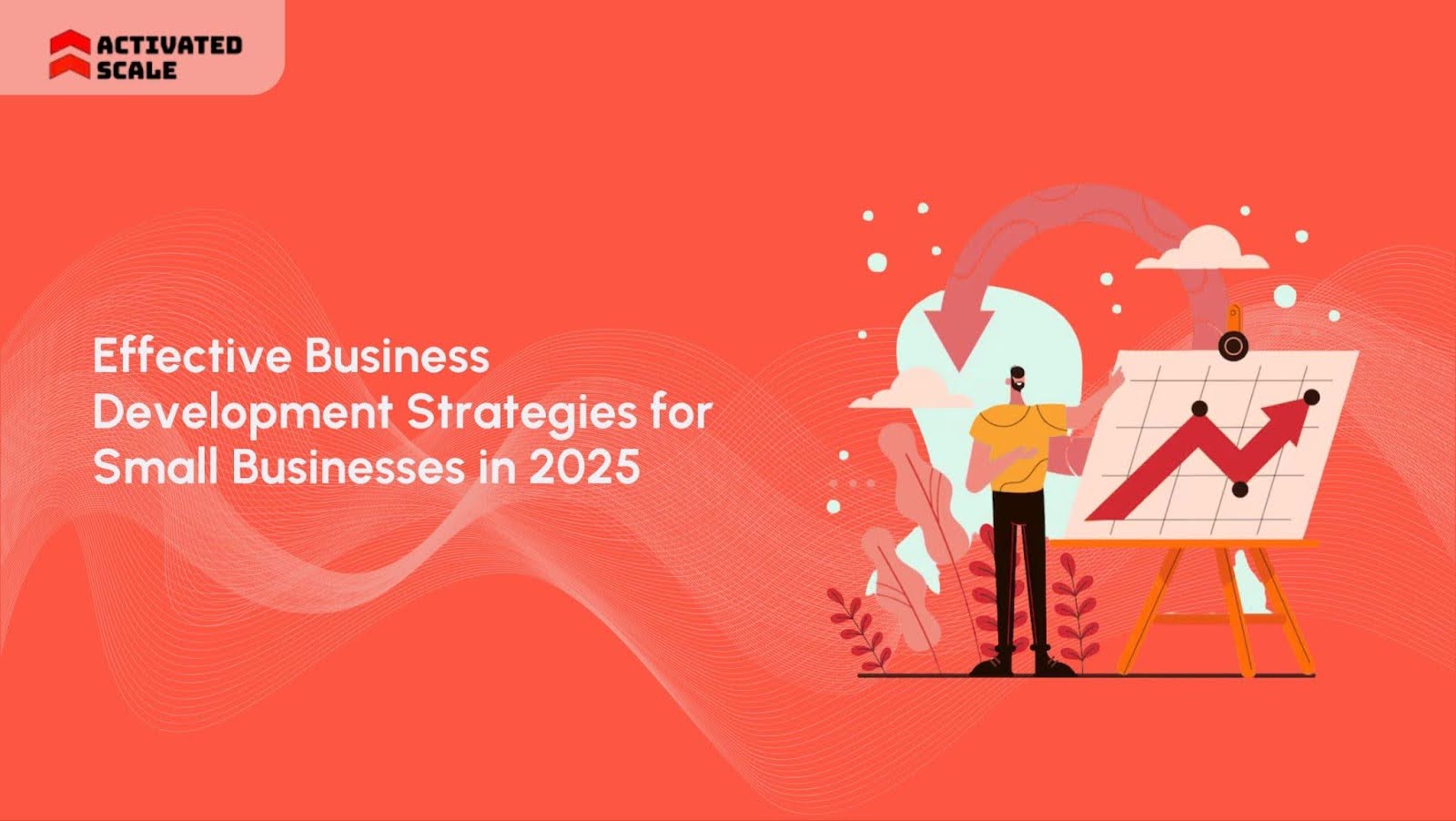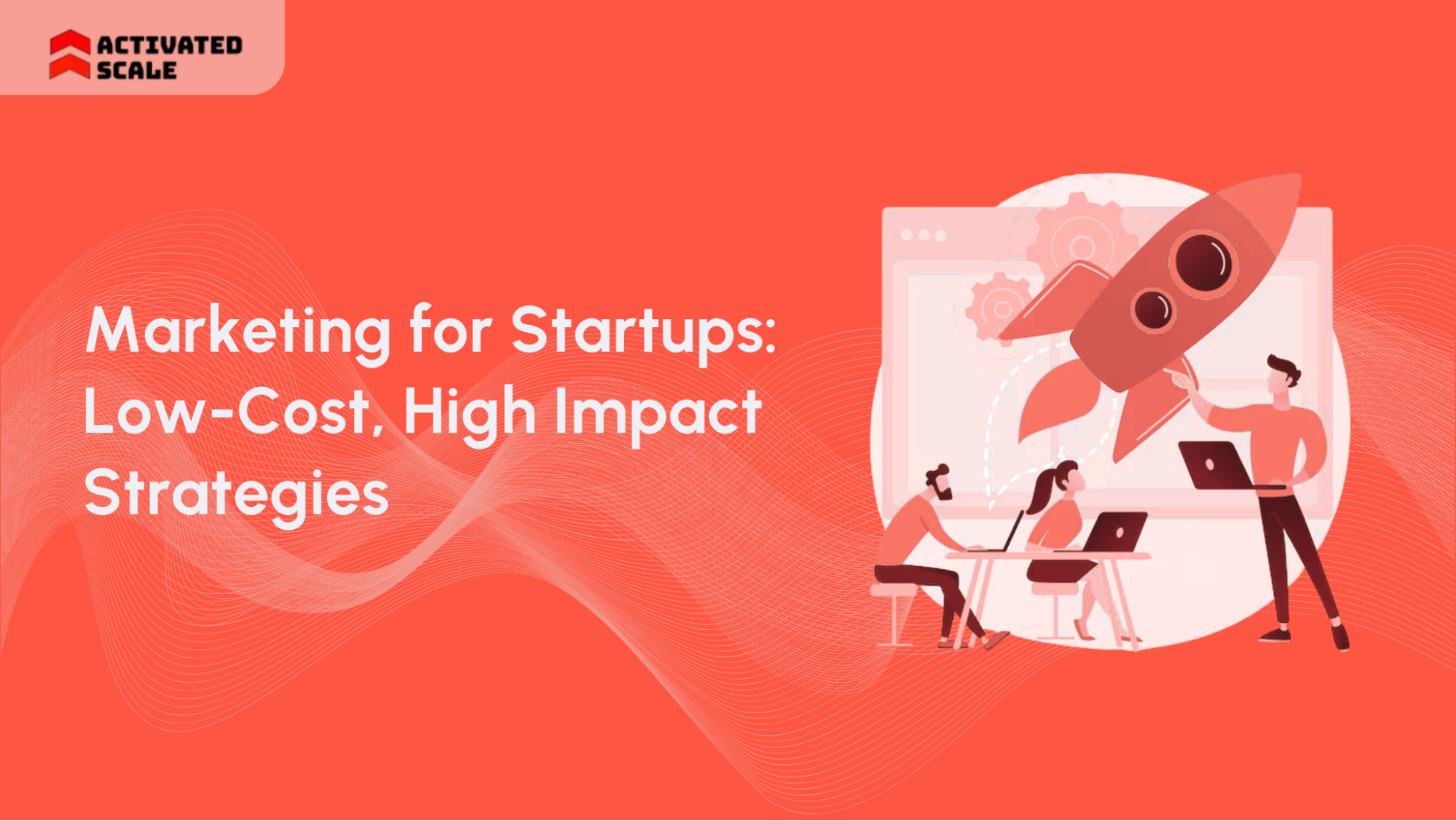More than 60% of small businesses around the globe are actively planning to expand their operations this year. This optimism is mirrored by the fact that small businesses now make up 99.9% of all companies in the United States, employing nearly half of the nation’s private-sector workforce.
These numbers are a testament to the restless, creative drive that defines entrepreneurs like you. Yet behind each new milestone lies a competitive, fast-evolving market where success is neither guaranteed nor accidental.
Thriving in this environment demands an ongoing mastery of business development. By 2032, the global small business market is projected to nearly double, reaching $4,985 billion at a brisk 8.5% annual growth rate.
This explosive momentum is driven by those willing to reimagine their approach, adopt new tools, and rethink the very ways they connect with markets, customers, and talent.
This comprehensive guide will distill what the top-performing small businesses are doing differently in 2025.
In a Nutshell
- Modern business development for small businesses is about strategic, flexible growth using the right expertise, technology, and adaptable sales models.
- Approaches like fractional sales and contract-to-hire give small businesses cost-effective access to seasoned sales professionals, reducing hiring risks while driving pipeline growth and efficiency.
- The most successful teams integrate automation, build robust partnerships, and prioritize data-driven decision-making to accelerate results and stay competitive.
- Activated Scale connects small businesses with expert sales talent on flexible terms, helping them scale smarter and reduce operational risk.
Key Drivers of Business Development for Small Businesses
The way to sustainable growth is not about chasing every shiny tactic, rather, it’s about understanding and activating the real forces that move your business forward. Recognizing these key drivers is what sets high-performing small businesses apart.
1. Using Marketing Automation and AI
Marketing automation and AI is becoming the essential engine for small business growth. These technologies enable small teams to operate with the efficiency of larger enterprises, freeing up time for strategy, customer relationships, and scaling.
Why Automation and AI Matter for Small Businesses
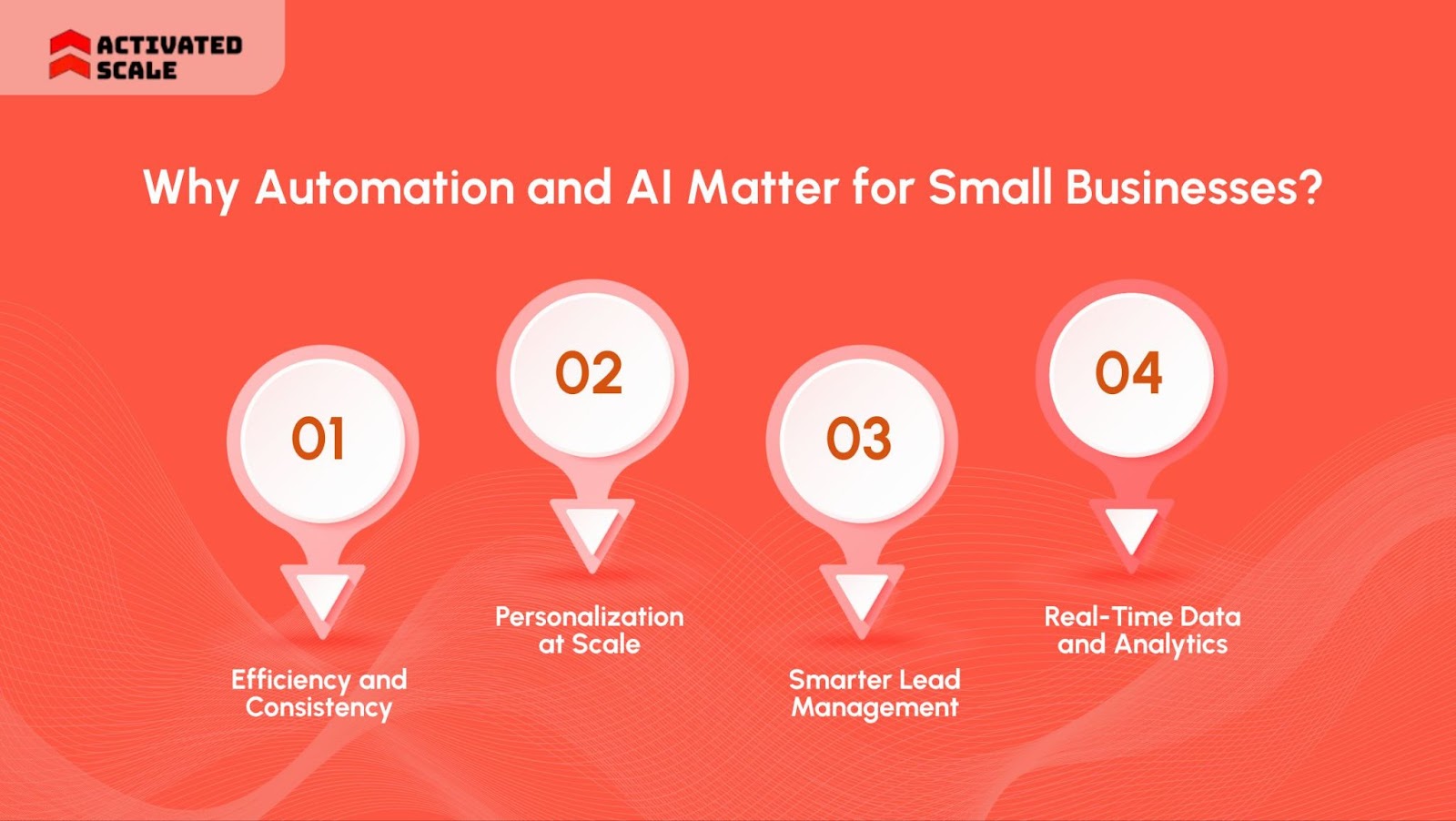
- Efficiency and Consistency: 76% of companies saw a positive ROI within a year of implementing automation. Marketing automation tools handle repetitive tasks like sending follow-up emails, segmenting leads, and managing social posts.
- Personalization at Scale: Personalized emails alone generate up to 6x higher transaction rates compared to generic blasts. AI-driven platforms analyze customer behavior, preferences, and purchase history, enabling you to deliver the right message to the right person at the perfect moment.
- Smarter Lead Management: Advanced lead scoring and nurturing allow you to identify which prospects are most likely to convert, ensuring your sales team’s time is spent wisely.
- Real-Time Data and Analytics: Automation platforms track every customer interaction for instant feedback on what’s working and what isn’t. This means you can continuously optimize campaigns and pivot with agility instead of relying on gut instinct or slow reporting cycles.
Practical Ways to Use Automation and AI.
Also Read: How AI Is Transforming Contract Sales Outsourcing In 2025
2. Building Strong Referral Engines, Partnerships & Community
For small businesses, growth often starts with relationships. Since trust is considered currency for business, a well-developed referral engine, thoughtful partnerships, and an engaged community can unlock exponential business development.
Why This Matters for Small Businesses
- Trust Multiplier: Recommendations from peers or known businesses drive purchase decisions. 92% of consumers trust referrals from people they know, making referral engines a high-ROI growth strategy.
- Network Effect: Strategic partnerships allow small businesses to “borrow credibility,” tap into new networks, and access opportunities otherwise out of reach.
Practical Strategies
- Formalize Referral Programs: Create simple, transparent incentives for your customers and partners to refer others. Referral bonuses, discounts, or even public recognition can encourage ongoing advocacy.
- Nurture Partnerships: Seek win-win relationships with complementary businesses (e.g., cross-promotion, co-branded events, joint packages). These can accelerate access to new client bases and deepen community roots.
- Engage Your Community: Consistently give back: host workshops, sponsor local events, or support causes your customers care about. Genuine involvement grows loyalty and word-of-mouth organically.
- Count on Testimonials & UGC: Showcase real customer stories and user-generated content across digital channels to provide social proof and inspire referrals.
3. Mastering Customer Relationship Management (CRM)
A modern CRM is the compass for small business business development, guiding every interaction, revealing growth opportunities, and helping you build bonds that last.
Why is CRM Essential as a Business Development Strategy for Small Businesses?
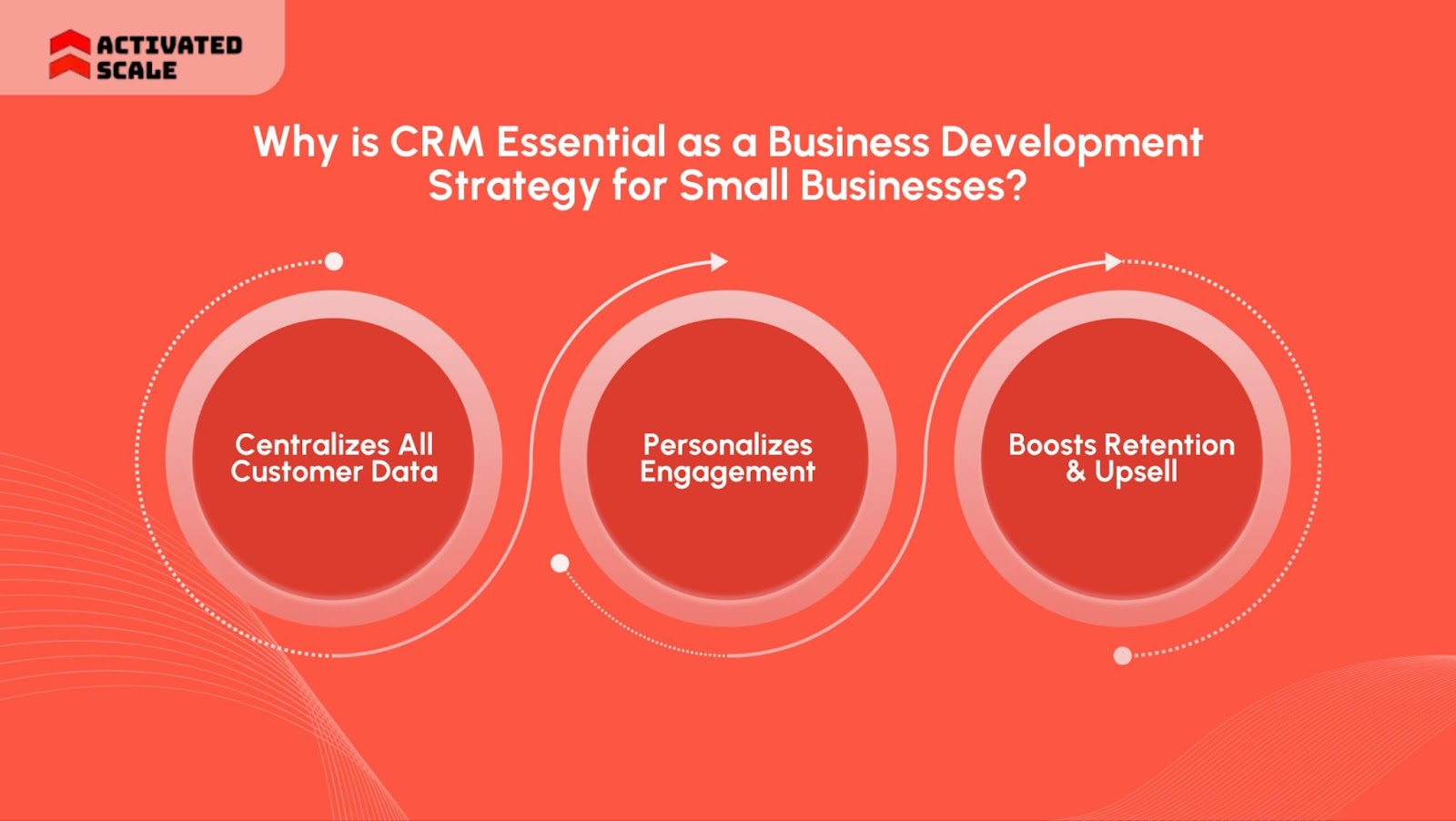
- Centralizes All Customer Data: No more scattered spreadsheets; every interaction, note, and deal is tracked, updated, and visible to your team in real time.
- Personalizes Engagement: Use smart segmentation to tailor your messaging, CRM platforms help you remember birthdays, preferences, purchase history, and follow-up seamlessly.
- Boosts Retention & Upsell: Identifying high-value customers and tracking engagement enables more targeted outreach, resulting in higher retention and expanded wallet share.
How to Make CRM Work for You
- Choose the Right System: Opt for a CRM that’s intuitive, scalable, and fits your business size, overly complex systems risk underutilization. Popular choices for small businesses include HubSpot CRM, Zoho CRM, and Pipedrive.
- Automate Workflows: Set automatic reminders for follow-ups, renewals, or re-engagement. Automation minimizes missed opportunities and ensures flawless customer care.
- Integrate Across Channels: Connect your CRM to email, social, ecommerce, and support, creating a 360-degree view of each customer.
- Analyze & Act: Use built-in dashboards and reports to spot sales trends, track KPIs, and adjust your strategies with data-driven confidence.
Also Read: Top 10 Best CRM Software for Small Businesses in 2025
5. Streamlining with Business Process Automation
Business process automation (BPA) uses technology to automate routine operational tasks, allowing small businesses to drive efficiency and scale without adding headcount.
By replacing manual, error-prone processes with automated workflows, businesses can free up time, reduce costs, and maintain consistency across departments.
Why BPA Matters for Small Businesses
- Efficiency Without Hiring: Automating repetitive tasks, like data entry, approvals, or reporting, lets your team focus on strategic growth activities rather than administrative overload.
- Error Reduction: Automated workflows minimize human error by standardizing processes and ensuring compliance with set rules.
- Scalability: Automation creates robust systems that scale smoothly as your business grows, without the growing pains of adding staff for every incremental task.
- Better Visibility and Control: With automated workflows, small businesses get real-time insights into process bottlenecks and performance, enabling faster adjustments.
Also Read: 17 Outbound Sales Automation Tools to Simplify Your Sales Process
6. Market Expansion & Product Diversification Strategies
Expanding your market reach and diversifying your product or service offerings are critical strategies to sustain growth and reduce risks in uncertain or saturated markets.
Key Considerations for Market Expansion
- Identify New Customer Segments: Use market research and data analytics to find underserved demographics or niches that match your offering.
- Explore New Geographies: Regional, national, or international expansion can open fresh revenue streams. Understand local market nuances before entry.
- Test Market Entry with Pilot Campaigns: Use targeted marketing campaigns or smaller product launches to validate new markets before full-scale investment.
Why Product Diversification Helps
- Mitigates Risk: Offering new products/services reduces dependence on one revenue source.
- Addresses Evolving Customer Needs: Continually innovating helps keep your business relevant as customer preferences shift.
- Unlocks Cross-Selling Opportunities: Bundling or complementary products can increase sales per customer.
Steps to Successfully Diversify
- Analyze customer feedback and behavior to identify gaps or opportunities.
- Leverage your existing capabilities and assets to develop adjacent products or services.
- Pilot new offerings with select customer groups or markets.
- Build flexibility into your operations to support diverse product lines.
7. Measuring & Adjusting: ROI-Driven Development
Continuous measurement and agile adaptation underpin successful business development. Without clear tracking, businesses risk investing in ineffective strategies or missing growth opportunities.
Core Principles for ROI-Driven Development
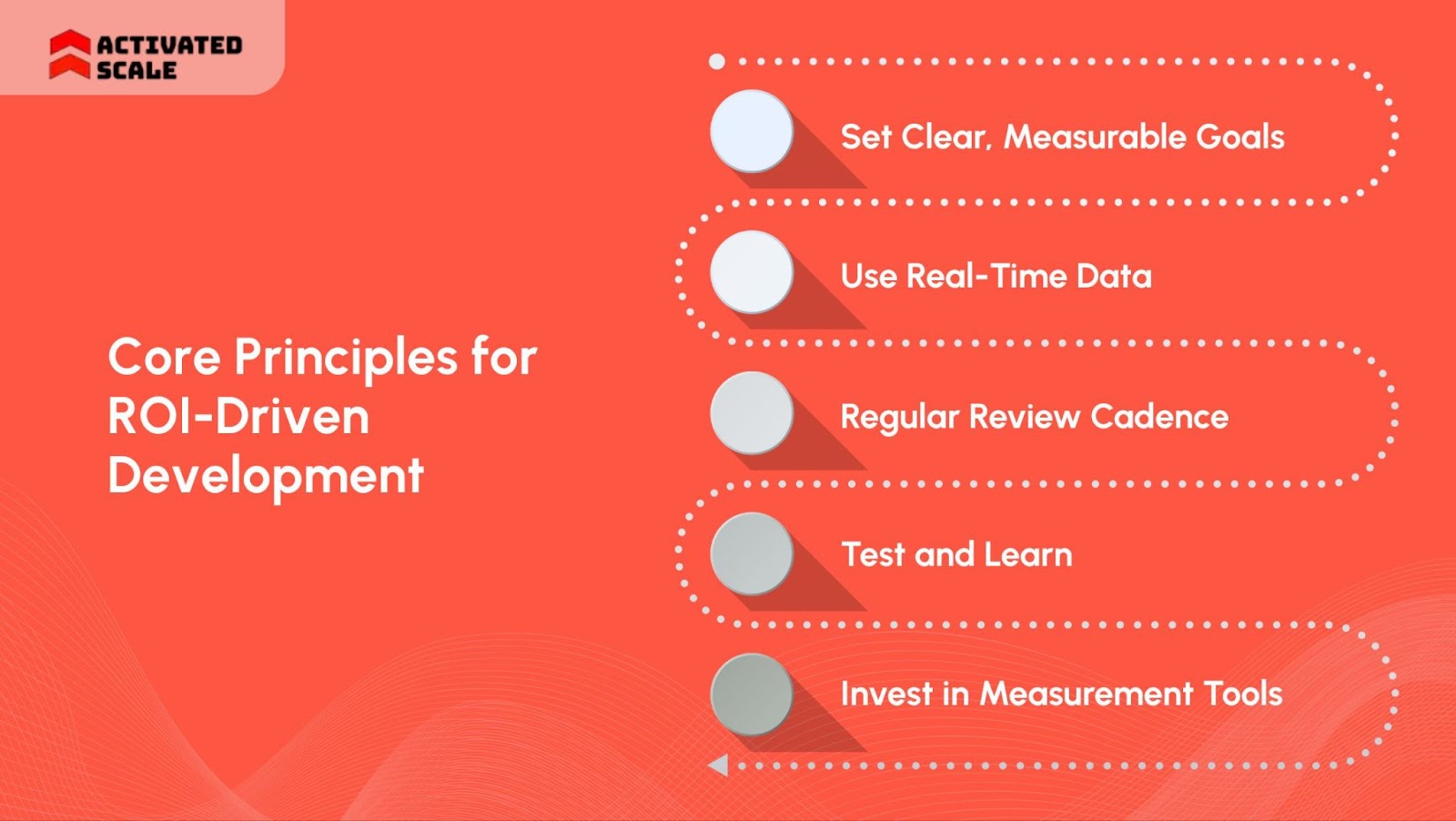
- Set Clear, Measurable Goals: Establish KPIs aligned to business objectives: whether lead volume, conversion rates, revenue growth, or customer retention.
- Use Real-Time Data: Implement dashboards and analytics tools that provide timely insights allowing you to spot trends and anomalies early.
- Regular Review Cadence: Schedule weekly or monthly strategy reviews to assess progress and refine tactics.
- Test and Learn: Treat campaigns and initiatives as experiments—test variables, measure impact, then scale or pivot based on results.
- Invest in Tools That Support Measurement: CRM platforms, marketing analytics, and financial reporting software are essential to tracking ROI accurately.
Benefits of ROI-Focused Approach For Small Businesses
- Maximizes budget efficiency by focusing spend on highest-impact activities.
- Empowers quick response to market changes and customer feedback.
- Builds a culture of accountability and continuous improvement within the business.
How Modern Sales Models Revolutionize Business Development for Small Businesses
Small businesses face sales challenges related to scaling business, like limited budgets, tight teams, and high market competition in growing their sales. Modern sales models such as fractional sales, contract-to-hire, and outsourced sales dramatically shift from this by delivering flexibility, expertise, and cost-efficiency previously reserved for larger companies.
Why Modern Sales Models Matter for Small Businesses
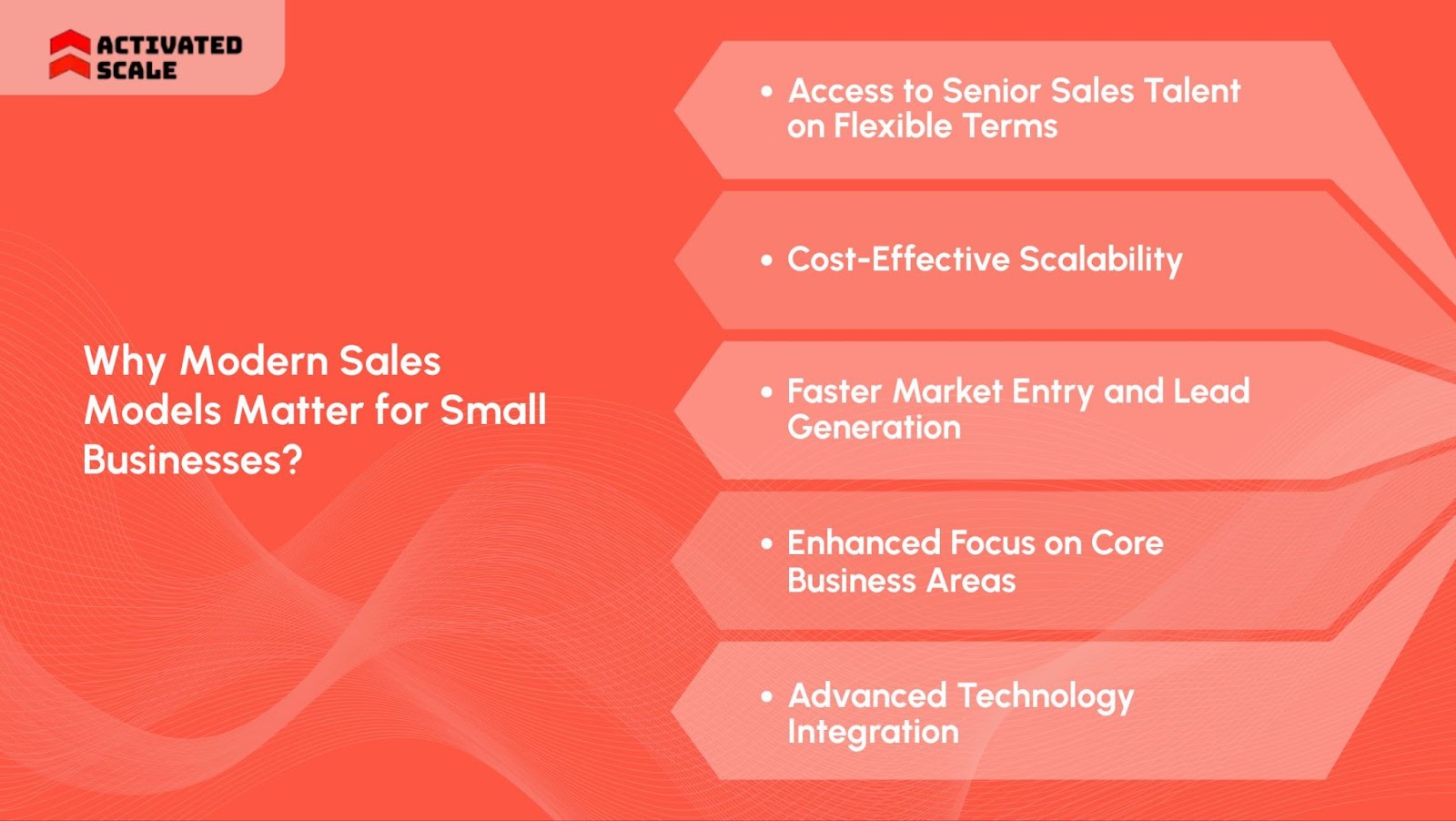
- Access to Senior Sales Talent on Flexible Terms
Fractional sales professionals work part-time or project-based for multiple clients, bringing deep expertise without the cost and risk of full-time hires. Contract-to-hire lets you test-fit salespeople before committing long-term, reducing hiring mistakes. - Cost-Effective Scalability
Turn fixed payroll costs into variable expenses linked to performance and needs. Scale your sales capacity up or down quickly in response to market changes without overhead burden. - Faster Market Entry and Lead Generation
Outsourced or fractional sales teams come equipped with ready networks, industry knowledge, and advanced sales tools, accelerating pipeline building and revenue generation. - Enhanced Focus on Core Business Areas
Delegating sales functions to specialists frees internal teams to concentrate on product, service delivery, and customer success, fueling overall business development. - Advanced Technology Integration
Access cutting-edge sales automation, CRM, and analytics through professional sales talent that might otherwise be cost-prohibitive, optimizing lead management and conversion rates.
Comparing Traditional vs. Modern Sales Models
How Activated Scale Helps Small Businesses Thrive
Activated Scale empowers small businesses to accelerate growth by providing direct access to vetted, US-based sales talent and leadership, all on flexible, scalable terms.
You can quickly integrate top performers into your team, test new markets with contract-to-hire, or gain seasoned guidance without a full-time commitment, whether you need SDRs, experienced account executives, or strategic sales leadership.
- Fractional Sales Talent: Build your pipeline and generate qualified leads without hiring full-time, Activated Scale’s SDRs and AEs become a seamless extension of your brand.
- Fractional Sales Leadership: Bring on proven sales leaders to architect your process, coach your team, and drive revenue at any stage of your growth.
- Contract-to-Hire Sales: Fill gaps or test new roles quickly and convert top talent to permanent hires only when you’re ready.
With a curated talent bench, fast onboarding, and a guarantee to rematch if the fit isn’t perfect, Activated Scale makes modern sales expertise accessible and stress-free for small businesses ready to level up
Also Read: How to Build a Scalable Sales Team Quickly
Conclusion
Business development for small businesses requires intentional strategies that combine expertise, flexibility, and measurable impact.
Growth happens when targeted sales talent is integrated precisely where it's needed, enabling faster pipeline building, optimized processes, and adaptable execution
Fractional sales and contract-to-hire models offer this adaptability without the financial risk of traditional hiring, providing businesses with access to seasoned professionals capable of delivering immediate results.
Activated Scale connects small businesses with carefully vetted sales experts who become true extensions of your team, not just temporary resources.
Take decisive steps to strengthen your business development strategy by booking a demo call with Activated Scale.
FAQs
1. What role do legal and regulatory requirements play in business development for small businesses?
Ensuring compliance with local, state, and federal regulations like the right business structure, obtaining the necessary permits, and adhering to employment laws, is critical for smooth operations and long-term growth. Overlooking these essentials can cause setbacks or financial penalties as the business grows.
2. What is the importance of having a formal business plan for small business development?
A well-crafted business plan acts as a roadmap, clarifying objectives, strategies, and financial projections. It is invaluable for securing funding, attracting partners, and keeping the business focused on sustainable development.
3. How do contract-to-hire sales arrangements typically work for small businesses?
In a contract-to-hire model, a sales professional is engaged on a temporary basis (often through a staffing agency), allowing the business to assess performance and fit before making a full-time job offer. This trial period helps both the business and the sales rep determine long-term compatibility with lower risk.
4. What challenges do small businesses commonly encounter when trying to scale operations?
Common pitfalls include lack of strategic vision, inadequate funding, founder dependency, and issues with hiring or retaining skilled employees. Recognizing these challenges early and planning for them is essential to avoid growth stalls.
5. How should a small business decide which sales model is right for them?
Choosing the best sales model depends on factors like current budget, growth stage, internal expertise, and business goals. Fractional sales may suit those needing senior guidance for limited hours, while contract-to-hire can help companies trial new roles. Evaluating your priorities and resource constraints will help determine the most strategic fit.
The Ultimate Guide to Hiring a Salesperson!
Get the step-by-step guide to hiring, onboarding, and ensuring success!
_edi.png)
